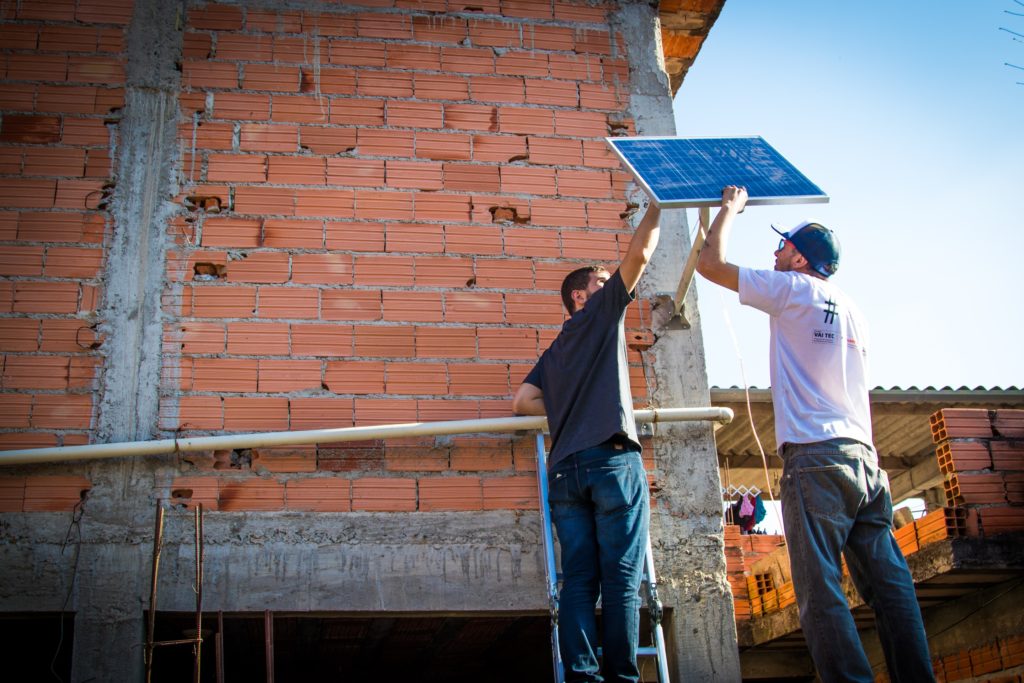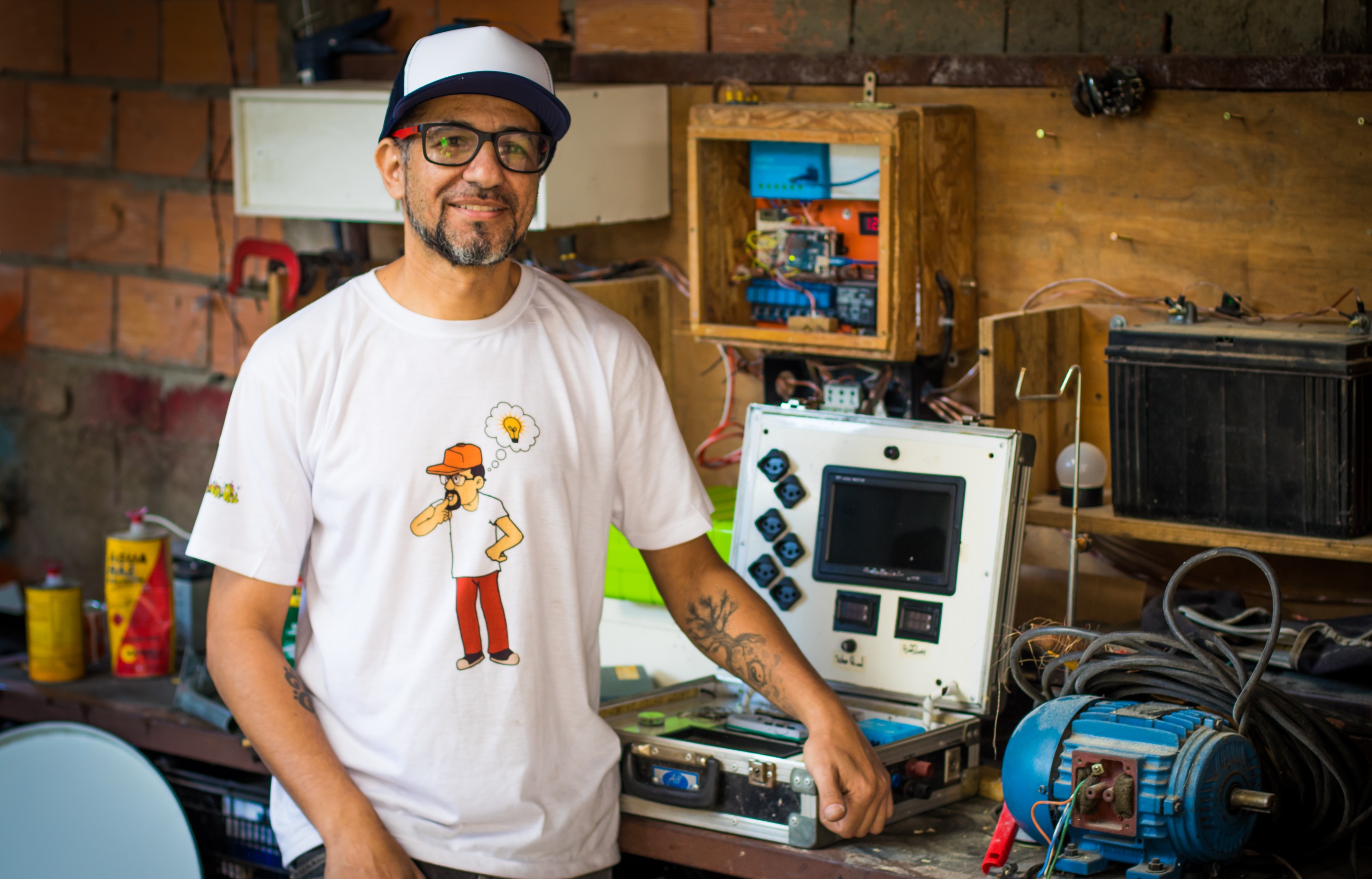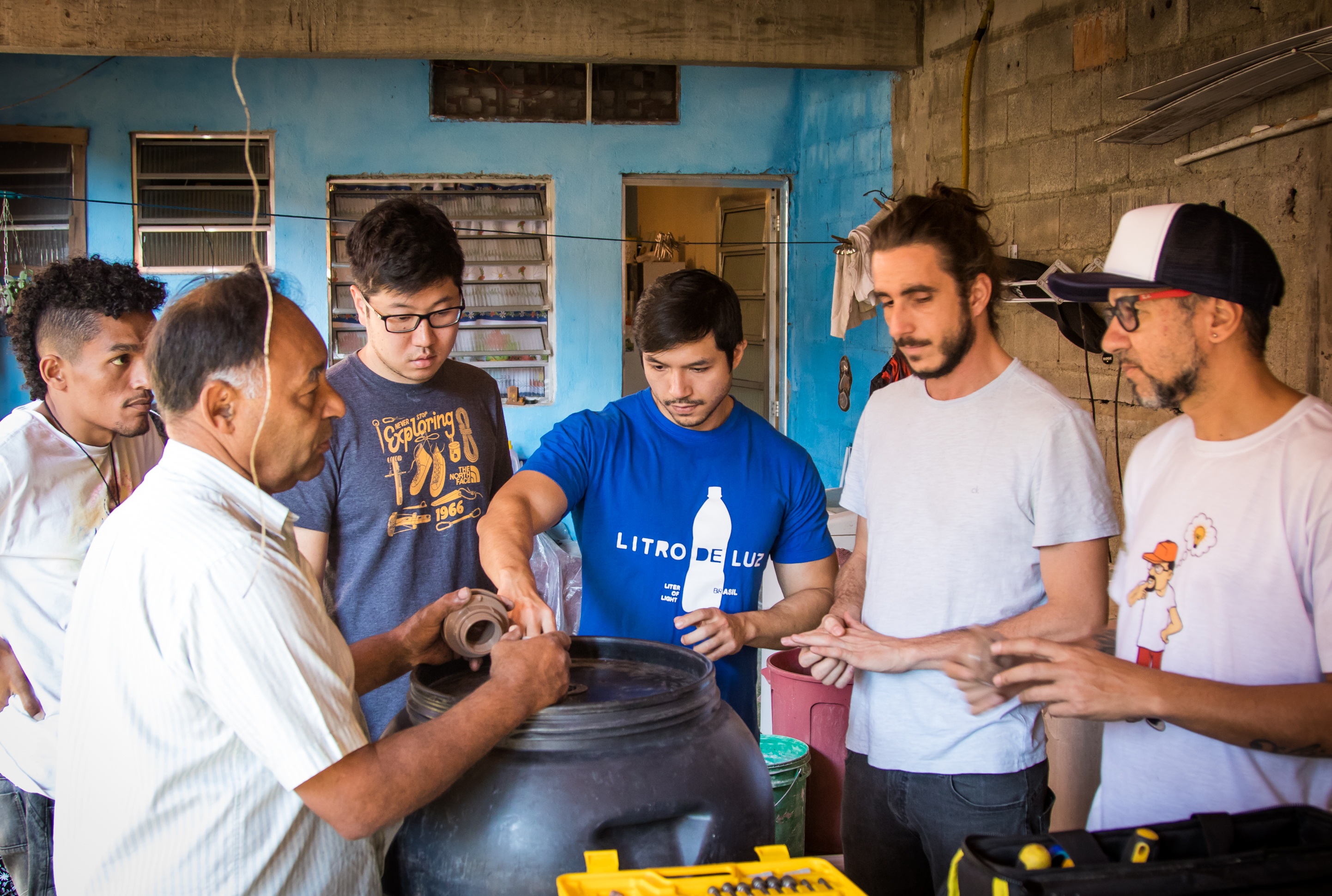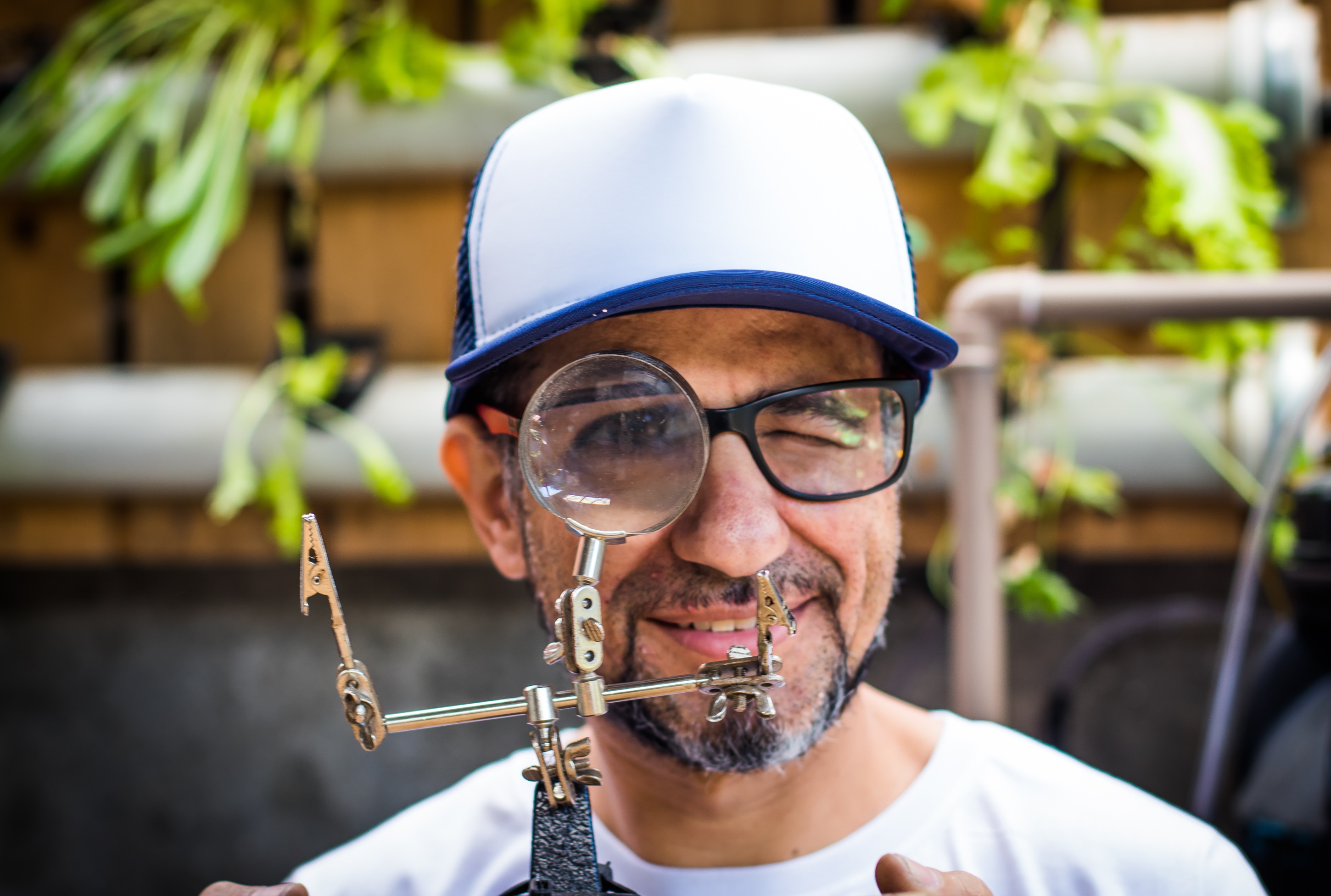On the roof are metal plates that capture the energy of the sun. In one corner, the biodigester works, converting organic waste into cooking gas. From the biodigestor, you can see PVC pipes allowing the biodigestion process to create the organic slurry. On a table are tools, including a gadget with cables and connectors: a portable photovoltaic storage system that can turn sunlight into electricity. All these things fit into an area of 12 square meters (39 square feet), a futuristic lab with a backyard feel, in Jardim Ângela, one of the most populous neighborhoods of São Paulo. This is where the Miranda de Moura family began developing systems to transform their neighbors’ houses into models of energy sustainability.
“We want to prove that everybody can develop a sustainable project that works,” says musician and “inventor” Fabio Miranda de Moura, 39. “I’ve only studied up to high school – I don’t have an advanced degree in anything. If I can create things, everybody can do the same.”
Fabio Miranda de Moura is called ‘Gyro Gearloose’ by his friends, in reference to a Walt Disney cartoon character, a chicken who is an inventor. Miranda de Moura spends most of his time at home, where he teaches free courses on renewable energy.

Installation of a photovoltaic panel in a São Paulo house, part of the renewable energy training course offered by Favela da Paz Institute (Junior Sá/Believe.Earth)
Over the past five months, he and his students have implemented biodigestion and solar energy systems in seven other homes and public places in the neighborhood. In a place with little infrastructure, making the suburb ever greener and more self-sufficient is not an option but a need. “Our idea is to teach more people and build more systems in more houses in a collaborative way,” says Fabio Miranda de Moura, who recently has given 15 lectures in public schools to more than 5,000 young people. In 2018, he intends to offer workshops on renewable energy for children and teenagers, with help from neighborhood residents who have already gone through his 10-month training course. The workshops will be offered free of charge by Instituto Favela da Paz (Peace Slum).
Since 2010, Favela da Paz has run educational programs to promote social entrepreneurship, sustainability and a culture of collaboration in this suburban area. “Taking care of the environment and of our relationships, that is what sustainability means — you cannot separate these things,” says Fabio. The project is called Periferia Sustentável (Sustainable Suburb). “In the slum, we have very little, so we depend on a friend or neighbor’s help to make things happen,” says Claudio Miranda de Moura, 40, Fabio’s brother and a co-founder of Favela da Paz. “That’s why I believe the future will be all about collective action. It’s the only way we can take care of each other.”

View of Jardim Ângela, in São Paulo. With more than 295,000 inhabitants, it was considered the most violent neighborhood in the world in 1996. It is still among the five most violent in the city (Raphael Poesia/Believe.Earth)
The inspiration for what is now Favela da Paz came after Claudio spent four months living in southern Portugal’s Tamera, one of Europe’s most important ecovillages. He went there in 2009 on a friend’s invitation. “When I came back, I said to Fabio: ‘They are creating things, some plates where the sun hits and generates energy. We must do the same! Quit your job and let’s start doing this!” remembers Claudio. A year later, Fabio went to Tamera, too, thanks to his savings and support from the inhabitants of the ecovillage.
Elem Fernandes, 31, Claudio’s wife, joined Fabio on that trip. She says the learning experience in Europe, and her own taste for the kitchen, gave her the idea for the project Vegearte,to promote vegetarian gastronomy in the neighborhood. She offers lectures and workshops on the consumption of healthy foods and the use of biogas. “Slums already have the culture of sharing,” she says. “We want to reinforce this essence along with the importance of cooking with what we have at hand.”
The NGO also maintains a recording studio for independent musicians, and there, too, it raises the banner of sustainability: Egg cartons provide acoustic insulation, discarded guitars and drums have been turned into chandeliers and the ventilation system was designed to cool the place with no need for an air conditioning system. In fact, it was in this studio that Favela da Paz’s history began.
A REFUGE IN MUSIC
Music was responsible for encouraging the brothers to develop social projects in their neighborhood. In 1989, they created a band called Poesia do Samba (Samba Poetry), and offered classes to more than 300 young people from Jardim Ângela. They used recycled buckets and pieces of metal to provide beats or harmonies, due to the lack of musical instruments. Years later, their band changed its name to Poesia Samba-Soul (Samba-Soul Poetry) and the shows generated income for the artists and inspiration for other local groups. Nowadays, the studio is used by about 100 musicians per month.
Music was also a way to bring the message of peace to a place that bore the stigma of violence. In 1996, Jardim Ângela was considered the most dangerous neighborhood in the world by the United Nations, surpassing many that were mired in civil war. “We had no jobs, local businesses or social projects,” remembers Claudio. “You could see poverty everywhere. It was almost a battlefield. It was common to see dead people in the streets.”
Even in the middle of this reality, the Miranda de Moura family never wanted to quit their neighborhood. José Gerson de Moura, Claudio and Fabio’s father, found a refuge in Jardim Ângela when he came from Sergipe in the 70s, fleeing the great droughts that devastated northeast Brazil. On the other hand, São Paulo was experiencing its largest population growth in history, with more than 2.5 million immigrants during that period. The sudden growth pushed most people to the suburbs. “My father always told us to be what we wanted to be, not what society wanted us to be,” says Claudio.

Claudio Miranda de Moura(left), Elem Fernandes and Fabio Miranda de Moura, founders of Poesia Samba-Soul and Favela da Paz, during Samba na 2, a free concert with local musicians in front of the NGO’s headquarters (Vera Plasencia Duhm/Cooperifa)
THE FUTURE
Today, Favela da Paz has employees and partners in America, Europe and Asia, including companies, organizations, schools and ecovillages. In São Paulo, the institute develops initiatives related to innovation, art, culture and sustainability that reach some 25,000 people a year.
In 2018, the NGO will take another step forward, migrating from its founders’ house to a new building with rainwater storage systems, solar energy, a green roof, an organic vegetable garden and the neighborhood’s first vegetarian restaurant. The objective is to create the country’s first fully self-sustaining community center, with LEED certification. The acronym stands for Leadership in Energy and Environmental Design and is awarded by U.S. Green Building Council, an NGO setting the prevailing standards for the recognition of sustainable buildings.
The project is in the fundraising phase and should cost more than R$3 million (US$935,000). But 15 engineering and architectural professionals are already volunteering their labor. The new venue will have space for lectures, workshops, social entrepreneurship courses, as well as for dance, theater, music and recreation for children and young people. It will also have a lab for the development of renewable energy, and a recording studio. You cannot disconnect the social from the sustainable, Fabio explains. “Sustainability is fashionable, but it’s also a reality,” he says. “I have an 8-year-old son and I want to build a healthy world for him and for the next generation. That’s why I work on this cause.”
- Claudio Miranda em frente ao biodigestor que alimenta a horta vertical: o final do processo não gera resíduo, pois vira gás para cozinha ou biofertilizante para as plantas (Raphael Poesia/Believe.Earth)
- Fabio Miranda de Moura attended neither college nor technical school, but he always had the talent to be an inventor (Junior Sá/Believe.Earth)
- Students in Favela da Paz’s free renewable energies course, during the assembly of a biodigester system in a neighborhood home (Junior Sá/Believe.Earth)
- Fabio Miranda de Moura at his ‘creation desk’ with a solar suitcase that generates its own energy, which can power it for up to 3 hours. Lightweight and portable, he uses it for lectures and events (Junior Sá/Believe.Earth)
Videos and images illustrating this report were produced by Ake Filmes, a production company started by young people, which grew out of an cinema project at Favela da Paz Institute.
Published on 12/22/2017









